Another year which brings another New Year’s piece. This year I knew I could not set a lot of type – it could not be a long piece like last year’s – as I am well into printing my next book, a narrative poem on Maimonides by Michael Castro – more about that soon, it is a big project and will likely be the subject of several blog posts.
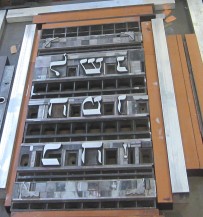
So this year’s card had to be more decorative. I have this Hebrew wooden type that I have not yet had an occasion to use. I decided that would be the design element. I decided to set the traditional holiday greeting, L’Shana Tova ( a wish for a Good New Year) with the wood type. The wood type and the joyous, exuberant greeting called for a joyous, spirited not too somber or serious accompanying text. As I went through my quote books, I remembered the Shehechianyu, the prayer we say as we approach or encounter the new. Perfect.
Adding as the third element a short line saying who printed it and when – known as the colophon – the design was completed.
I had this beautiful gray paper I had hoped to use on the Maimonides but decided to go a different direction with the book. It is an elegant handmade paper by the Twinrocker Papermill. Choosing the colors for this paper required a lot of trial; I must have tried 10 different colors, from blues to greens and even a purple. A grey led to silver for the Hebrew perhaps reminding us of all the silver shined in preparation of the holiday.
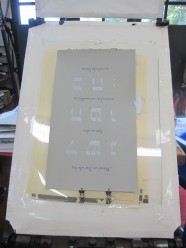
For the Shehechianyu prayer in English I selected the typeface, Eve (or Eva, Locarno), one of my favorite typefaces (I will buy any of it that anyone can find). Eve, an elegant and lively, yet somewhat eccentric typeface was designed by Rudolf Koch in 1922. Koch was one of the preeminent type designers of the time (see, Warren Tracy, Letters of Credit, 1986.) I framed the whole piece with an Art Deco corner ornament in yet a third color. The final element, the Colophon was printed in Palatino typeface and in black.
The piece was printed on the Albion where I could give the thick paper a good impression (the paper was very hard and didn’t take an impression easily.) The Albion press is a hand press and each sheet must placed on the frisket, a protective frame that prevents ink from being transferred to the paper. The paper is placed under the frisket, where a “window” has been cut out for the printing area and the paper is sent through the press for impression and printing. Each area to be printed sometimes requires a new window to be cut and attached to the frisket.
I think the elements came together very nicely: the silver wood type, the bright blue of the Eve typeface, and the more somber red of the corners. The silver reflects on the silver bindings popular for Jewish prayerbooks in the 18th-19th centuries and the Eve with its tall ascenders and capitals that is maybe not unlike the Rashi script connect us to the traditions and customs associated with our holiday.

The Details: Printed on the Albion Press on Twinrocker paper,
14 in. x 9 in. in an edition of 34.
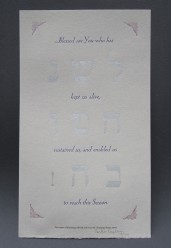
As the world was approaching the new New Year, I was still working on my old New Year’s card , my yearly Rosh Hashanah greeting. I can’t remember if I ever got any one out in time. I want to describe here how this card came to realization, a little about the text, a little about the design and printing.
I try to do something different every year, the text of course, but I like to try new things typographically. Sometimes it is with ornaments, sometimes it is with the layout of the piece, sometimes using a different printing press. Each offers a challenge. Each, I hope, reflects the Rosh Hashanah holidays.
The idea for a recipe card came quickly. Some of my best times are with friends and family centered around food. Shabbat dinners, interesting restaurants and my other passion, the quest for that perfect latte come to mind. And our holidays do have a food component, that can sometimes eclipse the holiday’s actual meaning.
I have been thinking about a book about food; what kind of cookbook, book of recipes, or a food-centric work I don’t know yet. I haven’t come up with anything yet but doing a recipe card was a good way to start.
What is the most quintessential (or some might think essential) dish all Jews partake of in one form or another? Tzimmes! I personally do not find it an appealing dish so I searched for a more palatable recipe than the traditional ones. I had Jayne Cohen’s book, The Gefilte Variations, in my library and enjoyed how she freshened up the flavorings in the traditional Ashkenzic dishes.
Tzimmes also has a meaning of tumult, a fuss, uproar. Taking that meaning, that most of our daily lives can be such a tzimmes and the holidays come to re-focus us, I also played with the ‘tz’ sound and paired it with my recipe of an antidote to the tumult in our lives. Using Tephila, T’shivah and Tzedakah, the three things we are asked to observe from the Unetaneh Tokef) prayer to lessen our fates: thus a tzimmes recipe to eat and a ‘tzimmes’ recipe to contemplate (http://en.wikipedia.org/wiki/Unetanneh_Tokef).
Can setting metal type also become a tzimmes? All those pieces of type and spacing assembled together to form words, sentences, to become a text? [insert image metal type] Maybe. I used two typefaces: Weiss, in roman and italic, for the text and Eve for the title. I am very fond of Weiss designed by the German typographer Emil Rudolf Weiss (1896 – 1965; http://en.wikipedia.org/wiki/Emil_Weiss; for a recent book about Weiss, printed letterpress, see http://www.inclinepress.com/ERWeiss.html). The typeface is available digitally but I am fortunate to have it in metal and I used this to handset the piece.I complemented the type with leaf ornaments, also designed by Emil Weiss.
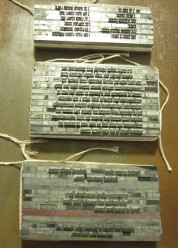
Recipe handset in Weiss typeface

On the Press: Weiss ornaments and Initials to be printed in brown
After setting the type and designing the layout, we are ready to begin the printing process. I decided to use three colors, using colors to suggest autumn. That means that I will do three runs – the paper will be printed three times, one for each color. The type has to be separated into the three color runs and set up on the press so that that all the elements fall into the right place in the finished piece [take a picture]. This is not always easy and takes some trial and error to get each form – the individual pages of type – in its right place.I’ll leave off here leaving printing for another day except to say I printed it on my Albion handpress, a press built in England, 1902. It is not the easiest presses to use but very satisfying as every step is determined by touch and feel from the inking to impression.I decided to use three colors, using colors to suggest autumn. That means that I will do three runs – the paper will be printed three times, one for each color. The type has to be separated into the three color runs and set up on the press so that that all the elements fall into the right place in the finished piece [take a picture]. This is not always easy and takes some trial and error to get each form – the individual pages of type – in its right place. I’ll leave off here, leaving printing for another day except to say I printed it on my Albion handpress, a press built in England, 1902. It is not the easiest presses to use but very satisfying as every step is determined by touch and feel from the inking to impression.
The piece is printed, my friends received it and my hope for everyone is that our year is full of humility, graciousness and generosity. Shana Tova.
The Details: 5 x 7 in. Printed on Rives BFK paper in Weiss Roman and Italic, title in Eve with Weiss leaf ornaments, in three colors. Unsigned in an edition of 35. Printed on the Albion handpress.
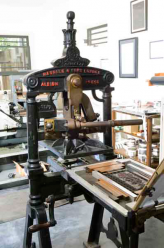
Albion Handpress
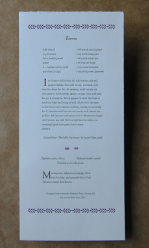
- Tzimmes
I was just reminded by a friend that the holidays are coming up soon and then he asked have I begun to think about my card yet. Of course not. But now I will. Can’t tell you all what I am thinking or the surprise will be ruined but I think it will be more traditional in format this year.
The design and printing of the card is my Elul, the month preceding the holiday where one begins the preparation of thought and deed in anticipation of the Holiday season. I look back on the year I have had and forward to the one I am hoping for. I think about what has been important to me, what I care most about, and build my piece from there.
More as we enter the month of Elul.








